Setting Up Permissions for Books
For books in a shared address book, the following permissions are set in the organization, user, or role.
- Access permissions
- Editing privileges
The permissions in the address book vary by security model.
The default setting is set to "REVOKE (All users have access except users on list)". This allows all users to view and edit the Address Book.
For information on permissions, refer to User Rights and Prioritized Access Permissions.
Setting User Rights
The example shows how to set access permissions when the security model is "GRANT (Only users on list have access)".
-
Click the administration menu icon (gear icon) in the header.
-
Click System settings.
-
Select "Application settings" tab.
-
Click Address Book.
-
Click Edit user rights.
If the book has not been set in the shared Address Book, Edit user rights does not appear. -
On the "Edit user rights" screen, select a book.
-
On the "User Rights List" screen, confirm that the security model is "GRANT (select target allowed)".
If the security model is set as "REVOKE (All users have access except users on list)", click Change to change the setting to "GRANT (Only users on list have access)". For details, refer to Changing the Security Model.
-
Click Add.

-
On the "Add new entry" screen, select the organization, user, or role, and then click Add.
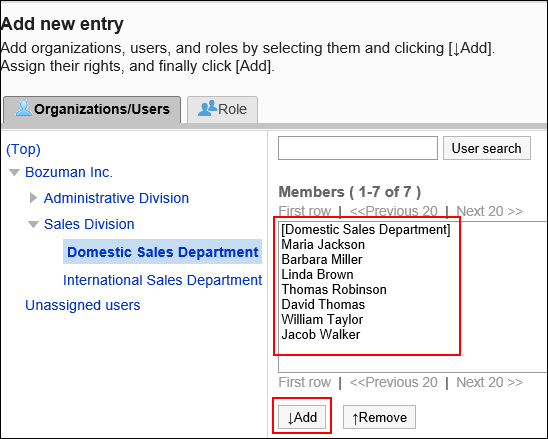 To select a role, switch the view to the Roles tab.
To select a role, switch the view to the Roles tab.
After you click Add then click the tab, the selected departments, users, or roles before you switch tabs are cleared. -
Under "User rights", select the checkboxes of the permissions to allow, and then click Add.
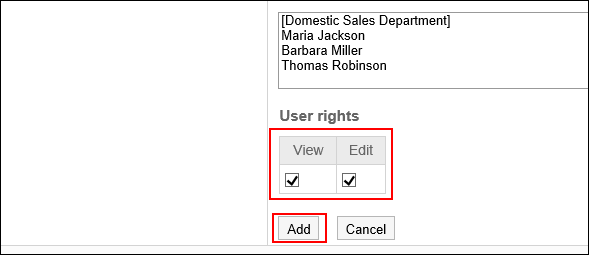
Combination of User Rights
Restricting the user rights of the address book allows only books that can be manipulated by users to be displayed on the Address Book screen.
Screen showing users who have the user rights:

Screen showing users who do not have the user rights:

If the security model is "GRANT (Only users on the list have access)"
This section describes the security model for access rights on the account book if GRANT is selected.
- Example of Allowing Daisuke Kato to Perform All the Actions on Business Partners:
Grant Daisuke Kato permission to view and edit.
- Example of allowing Daisuke Kato to view books for business partners:
Grant Daisuke Kato a permission to view items.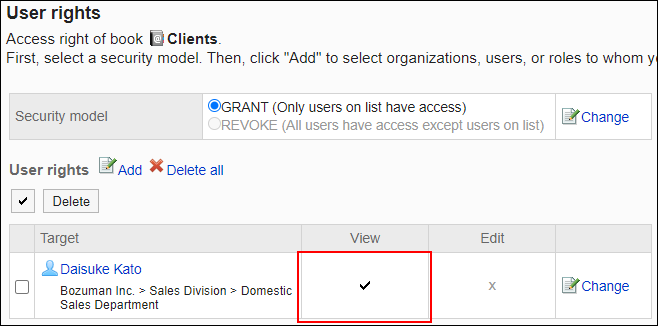
- Example of allowing Daisuke Kato to edit books for business partners:
Grant Daisuke Kato permission to view and edit.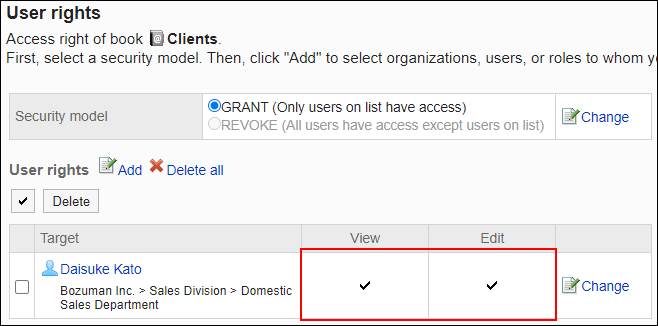
- Example of Prohibiting Daisuke Kato to Perform All the Actions on Business Partners:
Delete Daisuke Kato from the user rights list.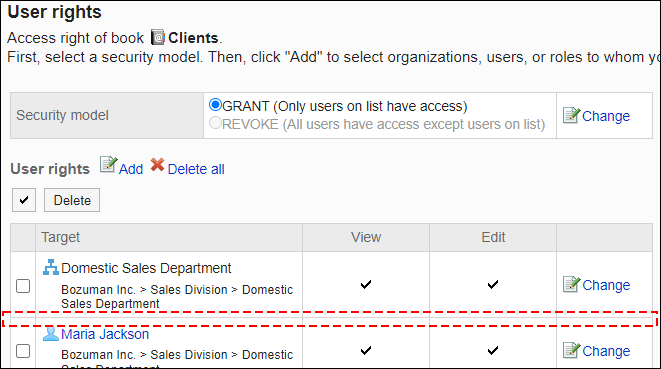
If the security model is "REVOKE (All users have access except users on the list)"
The security model for access rights to the account book is described in the "REVOKE (select a restricted target)" example.
- Example of Prohibiting Daisuke Kato to Perform All the Actions on Business Partners:
You can leave the view and edit permission from Daisuke Kato.
- Example of Prohibiting Daisuke Kato to Perform Edit Book Actions on Business Partners:
You can remove the editing privileges from Daisuke Kato.
- Example of Allowing Daisuke Kato to Perform All the Actions on Business Partners:
Delete Daisuke Kato from the user rights list.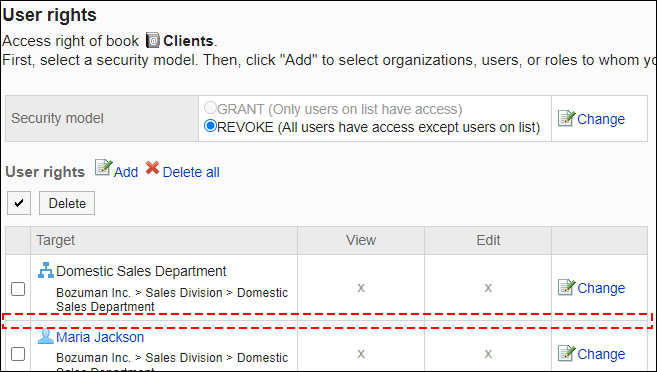
Changing User Rights
Change access permissions granted to users and departments.
-
Click the administration menu icon (gear icon) in the header.
-
Click System settings.
-
Select "Application settings" tab.
-
Click Address Book.
-
Click Edit user rights.
-
On the "Edit user rights" screen, select a book.
-
On "User Rights" screen, click Edit for the user rights to change.
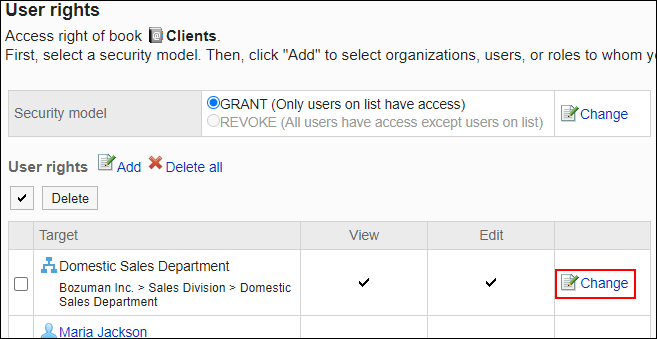
-
On "Edit user rights" screen, you can change the user rights as needed.
-
Confirm your settings and click Save.
Deleting User Rights
You can delete user rights to books that have been granted to users and organizations.
If you delete user rights, actions that users can perform changes as follows depending on the security model:
- If the security model is "GRANT (Only users on list have access)":
Users who were deleted the user rights or users who belonged to the departments or roles that lost user rights no longer be able to work with items they previously could. - If the security model is "REVOKE (All users have access except users on list)":
Users who were deleted the user rights or users who belonged to the departments or roles that lost user rights can now work with items they prohibited to use.
Selecting and Deleting User Rights
Select and delete user rights.
-
Click the administration menu icon (gear icon) in the header.
-
Click System settings.
-
Select "Application settings" tab.
-
Click Address Book.
-
Click Edit user rights.
-
On the "Edit user rights" screen, select a book.
-
On "User Rights" screen, select the checkbox for the user rights to delete, and then click Delete.
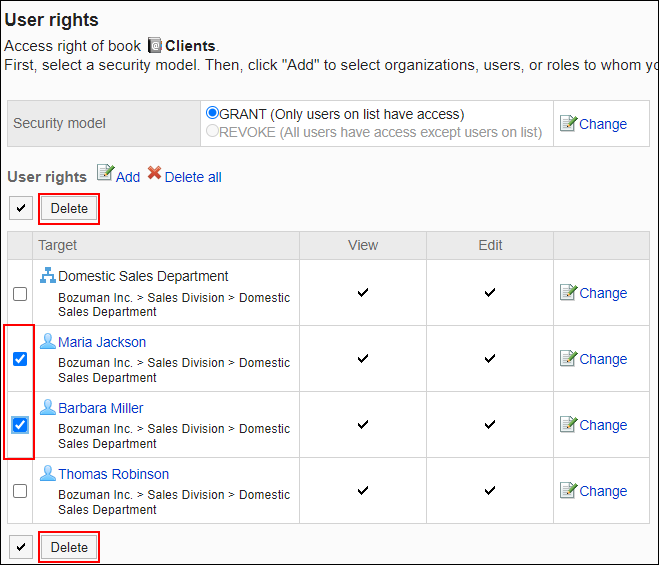
-
Click Yes on "Delete user rights" screen.
Deleting All User Rights
Delete all user rights.
-
Click the administration menu icon (gear icon) in the header.
-
Click System settings.
-
Select "Application settings" tab.
-
Click Address Book.
-
Click Edit user rights.
-
On the "Edit user rights" screen, select a book.
-
On "User rights" screen, click "Delete all".
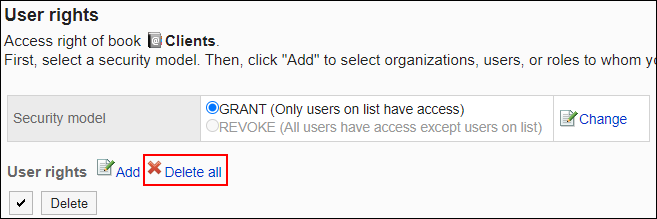
-
Click Yes on "Delete all user rights" screen.